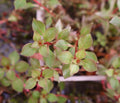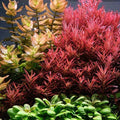Top 4 Rocks Used for Aquascaping That Beginner Hobbyists Use
The use of rocks as a decorative component of a tank is highly common in the aquascaping world, and as the art has developed, so has the need for rocks in a wide range of shapes and qualities.
Typically, a lot of rock material is required to build up an aquarium, especially if we want an Iwagumi-styled layout with a lot of stones and plants.
Because of this, it's important for us to understand how each rock we add to the biosystem will affect both its aesthetics and chemistry.
However, not all types of rock can be used in aquariums. Additionally, it is based on the kind of aquarium and the variety of aquatic life. We'll look at these 4 kinds of rocks that may be used in freshwater and how it can create an interesting and beautiful aquascape.
The Beauty of Rocks for Aquascaping
Rocks hold a significant role in the traditions and customs of many peoples. Think about Stonehenge and Easter Island, for instance. To discover that one unique rock that would create a "meditative mountain" in their garden, many people, especially in the Japanese culture, will hunt for a very long time—we're talking years here.
Other popular rock designs are those that allude to natural formations, water features, and scenery. Finding the ideal rock involves a lot of texture and form research. When selecting a rock for your aquascaping journey, aesthetics will play a significant role in your decision.
Ohko Stone (Dragon Stone)

The Ohko Stone, or "Dragon Stone," is a rock with a dragon-scale-like appearance. It usually has a greenish brown hue and is quite lightweight when compared to other hardscape rocks for aquascaping. The Ohko stone, according to aquascapers, is primarily made of baked clay, which is notoriously brittle.
The unusual dragon scale-like texture that results from natural erosion in the streams where it is sustainably gathered gives the Ohko stone or Dragon Rock its name. Rich browns, light grays, tans, reds, and greens are among the color choices. Comparatively speaking, it is a lightweight rock. Your environment may be centered on its natural beauty. Before usage, we advise a brief rinse.
If necessary, it is rather simple to cut the dragon stone into smaller pieces. In fact, it was a bit too simple! The enthusiast may frequently just pound a piece of rock covered in a towel with a heavy hammer.
Seiryu Rock

Seiryu Stone is a limestone-based metamorphic rock of Japanese origin that is very heavy and durable. It may be used in aquascaping to provide a gorgeous naturalistic environment that is ideal for both freshwater and saltwater aquariums. It is an excellent choice for anyone looking to build a lush and healthy aquarium because it is also known for its positive effects on plant development.
When it comes to cutting Seiryu Stone into smaller pieces, it might be a little challenging. It's unlikely that covering it with a towel and whacking it with a hammer will result in visually beautiful smaller pieces. I would advise using a hammer and chisel on this rock.
Lava Rocks: Red and Natural Gray

Red Lava Rock is a rocks for aquascaping that is used in many types of aquarium arrangements, such as planted tanks, freshwater aquariums, and saltwater aquariums. Known for its spongy texture, Red Lava Rock is frequently associated with aquatic or terrestrial mosses and epiphytic aquarium plants.

For planted aquariums, Natural Gray Volcanic Lava Rock, a spongy aquascaping stone, is also frequently used. It is ideal for achieving a natural look and may be used in freshwater planted aquariums. Highly porous, giving good bacteria and biofilm lots of surface area to grow.
The water chemistry in your aquarium won't be impacted by the inert substance. For a cleaner and healthier ecosystem, lava rocks create excellent natural biological filters that enhance water quality, increase oxygen levels, and regulate nitrates.
In the end, it all comes down to creating an integrated and aesthetic aquascape design. These top 4 rocks for aquascaping may make for a truly beautiful background in your fish tank.
I hope you have found what you were looking for in this post. Feel free to share your thoughts and comments below on what your favorite aquarium rocks are.
















